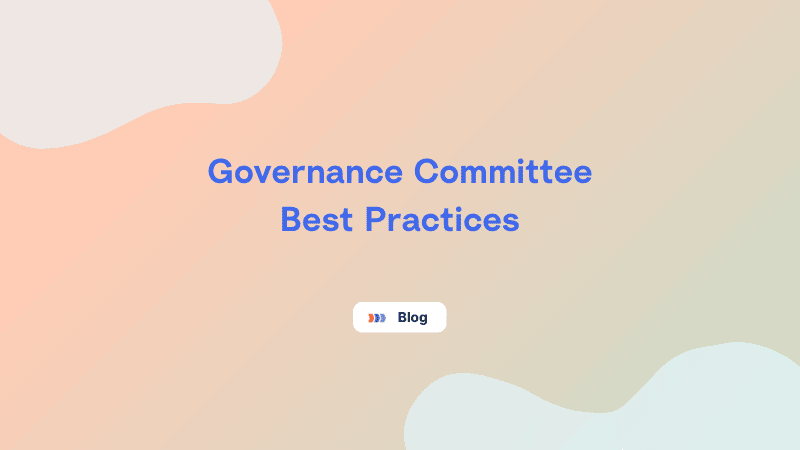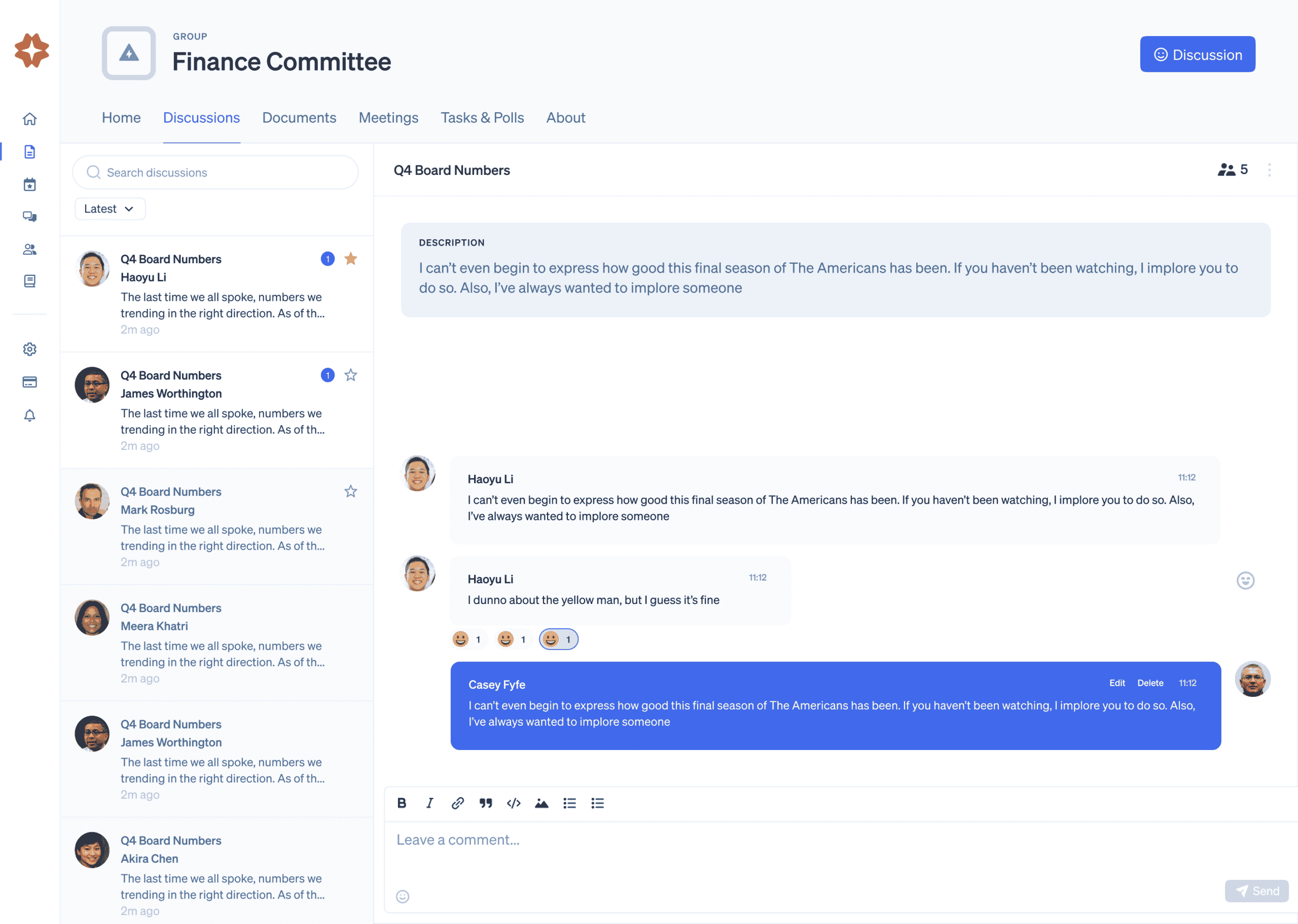A board committee is a committee established by the board of directors and is responsible for carrying out specific governance responsibilities. In this article, we’ll go through the best practices of governance committees.
Board Committees Composition
In an organization, a committee refers to a group of individuals working together to find solutions to common problems. The board establishes committees to oversee and carry out activities as required. Typically, a board committee is composed of the following committees:
- Nominating Committee – A nominating committee, also referred to as nominations and governance committees, is a group of board members responsible for the corporate governance of an organization. A nomination committee’s responsibilities include selecting nominees for election and recruiting the best candidates for the board of directors. In general, the nominating committee is also required to oversee the board’s corporate governance policies.
- Compensation Committee – The compensation committee determines the remuneration schemes for members of the Executive Committee, including directors and executive officers. Compensation may include annual retainers and per-meeting fees, corporate shares, stocks, perquisites, and other benefits. The compensation committee may also be tasked with reviewing expense reports and identifying frauds and/or compliance issues.
- Audit Committee – The audit committee is responsible for financial reporting and transparency. The audit committee reviews the organization’s finances once a year and guarantees that the board can quickly respond to regulatory questions.
Types of Committees
The different types of committees are as follows:
- Ad Hoc Committee – An ad hoc committee is generally temporary in nature. The board may establish an ad hoc committee for a limited time period to handle particular issues.
- Constitutional Committee – The role of the constitutional committee is to advise the board of directors on issues relating to the organization’s governance.
- Advisory Committee – An advisory committee is composed of people who bring their own set of skills and knowledge to the organization and may advise management on specific issues.
- Joint Committee – A joint committee is made up of individuals from several groups who meet to discuss issues of mutual interest in order to improve relations.
While the full board is responsible for overall decision-making, board sub-committees serve to improve corporate governance by discussing specific policies affecting an organization’s operations. Subcommittees focus on particular issues in more detail. The board may ask the subcommittees to evaluate their individual performance. Subcommittee examples may include those dealing with finance and audit, special projects, employee relations, communications, and others.
A subcommittee could be an ad hoc committee created for a single issue and has a limited duration, or a permanent subcommittee that meets periodically to discuss specific concerns and draft recommendations. In terms of subcommittee roles and responsibilities, subcommittees generally make recommendations to the committee, which finalizes the decision. Additionally, subcommittees are responsible for conducting internal and external reviews of proposals in their respective areas of focus.
A sub-committee meeting may be held in a less formal manner than a technical committee meeting, depending on the discretion of the subcommittee chair. A subcommittee meeting can be transformed into a committee meeting under certain conditions.
Governance Committee Best Practices
A board governance committee is responsible for helping the organization reach its maximum potential by reviewing the organization’s health and board effectiveness. One of the governance committee’s responsibilities includes making policy and procedural recommendations to the board for more efficient governance. The committee is also in charge of selecting, recruiting, onboarding, and supporting new board members. The governance committee charter establishes the governance committee’s responsibilities, determines the number of committee members and how they are appointed or dismissed, and specifies the composition of the committees.
A governance committee checklist, on the other hand, may provide more information about the important tasks. For instance, a best practice checklist may include questions regarding board governance, including governance policies and bylaws, governance committee structure, board roles and responsibilities, and meeting strategies and requirements.
When it comes to a nonprofit governance committee, best practices include designing an assessment questionnaire to understand how the board of directors view their roles in general, how they feel about their positions, and assessing their needs. Additionally, nonprofit organizations should also keep their meetings well-organized. Meeting management software, for example, can help teams stay connected and interact more readily even when they are working remotely. When it comes to the nonprofit governance committee, responsibilities are similar to for-profit entities.
The role of the nominating and governance committee in an organization is to help define governance policies, create a policy for board succession planning for board turnovers, and recruit new board members with appropriate skills and experience.
When it comes to nominating and committee best practices, it is important to develop a strong and diversified board structure that is suited for its purpose. This means that the board of directors should be composed of the organization’s most experienced members. When selecting board members, the committee should provide a clear job description and consider the directors’ long-term performance. Furthermore, the board of directors should play an essential role in promoting commercial integrity and ethical behavior. This is especially true when board members have conflicts of interest that could influence their voting process.
Governance Committee Structure
Regarding the difference between governance committee vs executive committee, The governance committee is typically made up of directors, the majority of whom are independent directors, whereas the executive committee is composed of the organization’s top executives, including the chairman of the board. Both are permanent or standing committees that an organization uses on a regular basis. The executive committee oversees board policies and ensures effective governance practices, while the board governance committee is in charge of how the board governs. Governance committees are also in charge of identifying, recruiting, and orienting board members. Meanwhile, corporate governance committees enforce ethical business practices and help the board adhere to industry regulatory requirements.
Organizations may benefit from using a governance committee charter template when creating a governance committee charter, which outlines the purpose and objectives of a committee, including governance committee roles and responsibilities. A government committee checklist further outlines the duties and key tasks of a governance committee.
Board Governance Checklist
It is critical that boards are diverse and are made up of highly qualified members in order to develop appropriate board governance policies. Board governance policies establish guidelines for board activities and allow boards and CEOs to function within a defined governance framework. Performance budgeting, implementing IT standards to safeguard sensitive information and ensuring that members stay compliant whether they work in the office or remotely are a few governance policy examples. A governance policy template might be helpful when creating an organization’s corporate governance framework.
When establishing governance policies, it may be beneficial for organizations to prepare a board of directors checklist, which can aid directors in minimizing risks when performing their duties and ensuring that organizations comply with legal obligations. A board roles and responsibilities checklist may also come in handy when training new directors and also reminding existing board members of their responsibilities.
Governance Committee Goals
Corporate governance helps in the resolution of ownership and control issues. Shareholders own a business and have their own objectives, and they may expect the board of directors to make sure that those objectives are realized. The directors, on the other hand, have their own set of goals and may not always deliver the shareholders’ intended outcomes. Corporate governance helps guarantee that board members act in a way that benefits the shareholders.
What is a corporate governance committee? A corporate governance committee assists the board members in performing their duties more efficiently. The committee can also assist in ensuring that the organization’s governance policies are transparently reported through the right channels.
In nonprofit organizations, governance committees often have the same responsibilities as those in for-profit enterprises. In a nutshell, the purpose of the governance committee is to make sure that the board fulfills its responsibilities in accordance with the organization’s constitution, articles, and by-laws. A governance committee nonprofit is also responsible for hiring and training new board members, as well as resolving possible board of directors’ conflicts of interest.
A governance committee charter template can be used as a starting point for establishing a governance committee charter, which specifies how a committee is made up. Additionally, the governance committee terms of reference should be carefully considered by the committee chairs to make sure that the board’s needs are properly addressed.
Board Governance Committees
Board governance committees may include directors, executives, and senior management. Some board committees have progressed from their original role of recruiting new board members. Board governance committee responsibilities may include supporting the long-term health of an organization by ensuring that the board functions efficiently. A governance committee charter template and a governance committee checklist may be useful when developing a governance committee charter. Checklists and templates can help guide you through the process of creating a board committee charter of any kind.
Nonprofit Governance Checklist
The best practices checklist for nonprofits may provide valuable insights on matters relating to financial management and regulation, governance and operations, and organizational mission and objectives.
Nonprofit organizations can benefit from following nonprofit governance best practices. These include identifying and prioritizing potential risks, such as mismanagement of finances, regulatory compliance, donor data breaches, and poor investments, by completing an annual risk assessment. In addition, nonprofit organizations might get into difficulties if they do not follow the provisions in their nonprofit governance documents, such as the conflict of interest policies and bylaws.
What is nonprofit board governance? Nonprofit board governance consists of mechanisms, norms, and processes that nonprofit organizations can use to make decisions, assure that decision-makers assume responsibility, and take appropriate action. Nonprofit policies and procedures PDFs and templates may be useful for nonprofit organizations when creating policy manuals. Nonprofit policy templates can be customized to reflect policies that are specific to your organization.
When it comes to the best practices of highly effective nonprofit boards, highly effective nonprofit boards set clear board expectations, particularly in regard to committee involvement and participation. Monitoring and reporting meeting attendance is one technique to gauge committee engagement. In addition, it is critical to attract qualified board members who will serve the organization’s best interests and to train new board members to be effective nonprofit ambassadors. Finally, it is essential to understand regulatory and compliance issues and how to manage them successfully.
Boardable’s board meeting participation solutions can assist organizations in increasing and improving board meeting engagement. Furthermore, by documenting meeting minutes and member tasks, which can be accessed through the Boardable dashboard, it will be easier to ensure meeting accountability.




